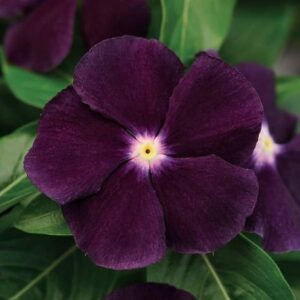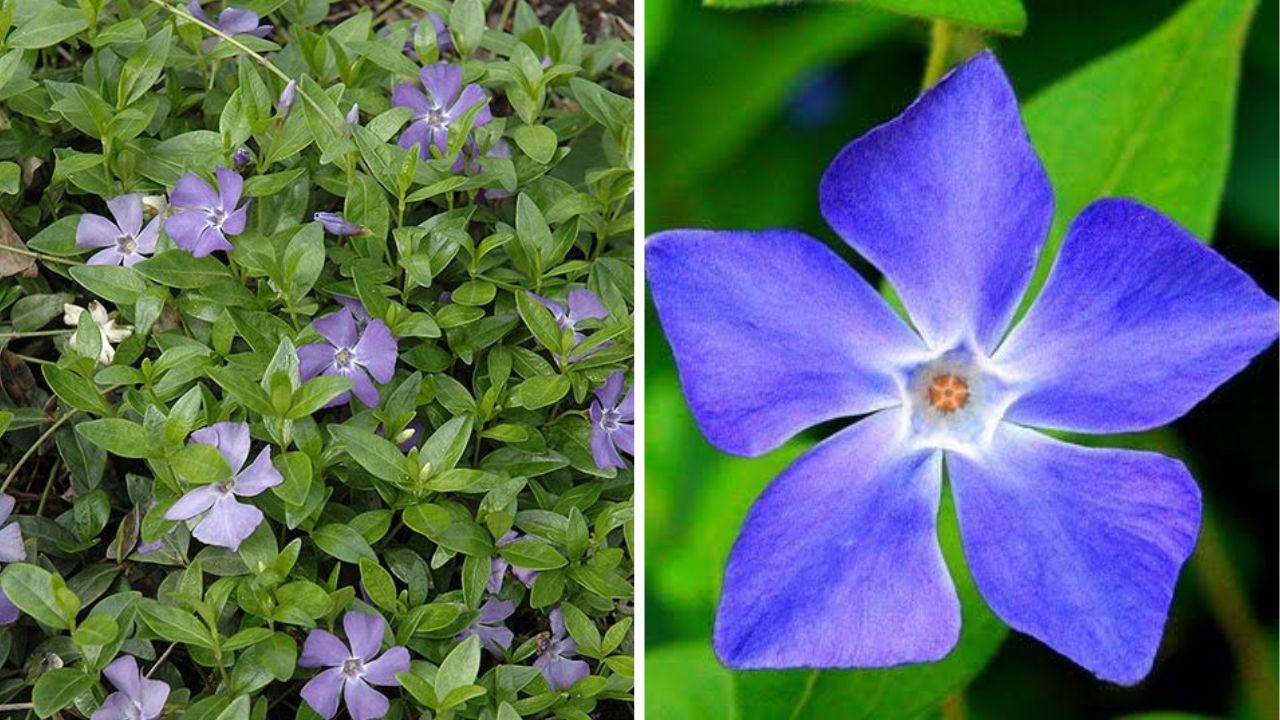Periwinkle plants (Vinca minor) are ground and bank covered with trailing, arching stems that root when they come into contact with soil. They have lavender-blue, five-petaled, pinwheel-shaped flowers that emerge in early spring in leaf joints, together with lustrous, oval, dark green leaves.
Because periwinkle can effectively compete with surface tree roots, it is a great plant to place around trees. Although it grows slowly, many vinca cultivars can spread quickly and aggressively, particularly when planted in deep shadows. Certain states require the plant to be moderately managed since it is deemed invasive. In the spring, immediately scatter seeds on the ground. Keep in mind that periwinkle poisons cats and dogs.
Periwinkle Plant Overview

| Common Name | Vinca minor, common & dwarf periwinkle |
| Botanical Name | Vinca minor |
| Family | Apocynaceae/dogbane |
| Plant Type | Perennial |
| Mature Size | 3-6 in. tall with trailing vines that grow up to 18 in. long |
| Sun Exposure | Full, partial, shade |
| Soil Type | Loamy, sandy, clay |
| Soil pH | Choose from acidic, neutral, alkaline |
| Bloom Time | Spring, summer |
| Flower Color | Blue, purple, white |
| Hardiness Zones | Choose from Zones 4-9 (USDA) |
| Native Area | Europe |
| Toxicity | Toxic to dogs and cats |
Periwinkle Care

It doesn’t take a green thumb to care for this plant. It grows well in a variety of conditions and is fairly resilient. This creeping ground cover spreads its roots anywhere it comes into contact with the soil. There isn’t a more dependable ground cover to grow beneath trees or for barren patches. Not only does it add an abundance of lush, green foliage to your garden beds, but it also works well in challenging terrain conditions including hills, slopes, and areas that are prone to erosion.
Plant larger species and selections of soil-tolerant periwinkle 2 to 2 1/2 feet apart; dwarf forms should be planted 1 1/2 feet apart. Shear the plants before fresh spring growth starts if they start to heap up or get coated with old stems. Periwinkles are unappealing to deer.
Light Requirements
Periwinkle thrives in low light conditions, such as partial shade, full shade, and part sun. Periwinkle plants may scorch if placed in direct sunlight.
Soil and Potting
Although it grows in most types of soil, to help with soil drainage and nutrient uptake, add some organic peat moss or compost mixture before planting.
Watering
Water your periwinkle plant until the roots are firmly established when you initially plant it. Keep the soil damp but well-drained to ensure it receives enough water. Douse the roots with water rather than the entire plant. Watering early in the day helps the vine’s leaves dry out in the afternoon and keeps mold and disease from growing. Once established, periwinkle can withstand some drought, but it prefers the damp soil that is typically found in locations that are shaded or partially shaded.
Temperature and Environment
Although periwinkle is resistant to extreme heat or cold, it is susceptible to sudden fluctuations in temperature. Although periwinkle can withstand humidity, it does increase the plant’s vulnerability to illness. Its preferred temperature range is 60 to 75 degrees Fahrenheit, which is rather warm. Bring an indoor potted periwinkle when the temperature drops below fifty degrees at night.
Fertilization
Fertilizer is probably not necessary because periwinkles may grow in poor soil. For periwinkle planted in soil deficient in organic matter, provide a balanced fertilizer as needed to promote flowers.
Types
Greater Periwinkle (Vinca major)

In MS, LS, and CS, Zones 7-9 (USDA) are where greater periwinkle grows. This species is bigger and more hostile. With two-inch-wide purple blossoms, the leaves can reach a length of three inches. The plant can become invasive in protected, shaded locations, grows quickly, and forms mounds up to 12 feet high.
“Variegata,” which is presumably just as common as the green variety, has heavily white-edged leaves.
Common, Dwarf Periwinkle (Vinca minor)

Dwarf periwinkle, sometimes known as common periwinkle, grows in US, MS, LS, and CS gardens in USDA Zones 6 through 9. With leaves that are between ¾ and 1 ½ inches long and blooms that are an inch large, this is a smaller version of Vinca major. It is less likely to overrun nearby plants and is more subdued.
- ‘Atropurpurea’ has tiny leaves and vivid purple flowers.
- “Illumination” features blue blooms and brilliant gold leaves with a green border.
- Larger leaves and darker blue flowers are characteristics of ‘La Grave’ (Bowles Variety).
- ‘Ralph Shugert’ has blue flowers and white-edged leaves; it blooms again in the fall.
- “Sterling Silver” yields blue flowers amidst leaves with pale green specks and white edges.
Pruning
Before fresh spring growth starts, mow or shear the plants when they become covered with old stems or when they mound up. To stop the plant from spreading, trim it frequently and cut off any runners.
Propagating Periwinkle
Periwinkle grows so well that it’s best to dig it up and divide it instead of trying to propagate it from seed or with a stem cutting. To split, take these actions:
- Excavate the area surrounding a plant. They don’t root too deeply, so you won’t have to travel very far.
- Take the plant out of the ground.
- To recreate the former growing conditions of the plant, dig a planting bed that is roughly the same size and depth as the excavated plant. Put the plant inside.
- Press the soil down.
- Once the plant is established, water it regularly after giving it a good start.
Potting and Repotting Periwinkle
Growing plants in hanging baskets or containers is a simple task. To plant, select a pot with holes for drainage and fill it with soil that drains well. Make a section of divided periwinkle plants in the ground. After the top two inches of soil have dried, move it to a spot with some shade and water it.
Overwintering
This resilient plant can withstand low temperatures. In the winter, add a layer of mulch around the base to shield the roots. As the weather cools off, move your potted periwinkle indoors.
Common Pests & Plant Diseases
Diseases and pests in gardens can still affect these plants. Aphids, white flies, and spider mites are common pests. Webbing or weakened, yellowing leaves could be signs of pest infestation. Apply neem oil or insecticidal soap for treatment. Keep an eye out for fungal diseases such as leaf spot, which causes black dots on leaves, and stem blight, which turns the stem black. If necessary, apply a fungicide to the plant. Water the plant at the roots to keep the foliage dry and to promote proper air circulation, as this will help prevent fungal illnesses.

Pingback: Eryngium (Sea Holly) Complete Guide To Grow And Care